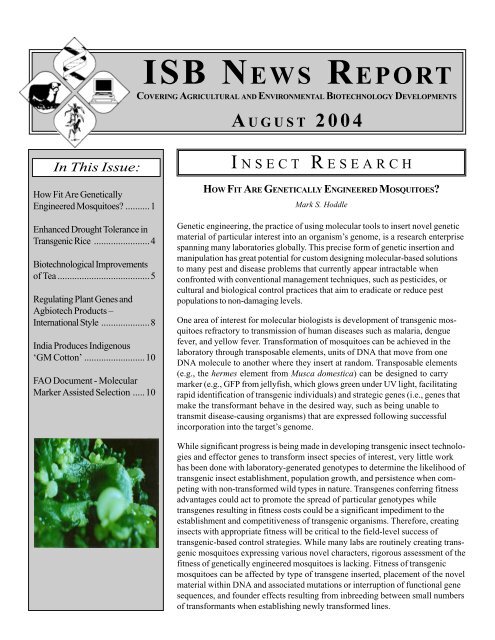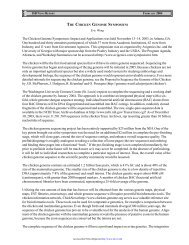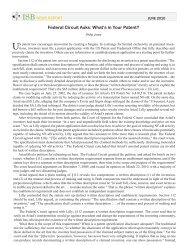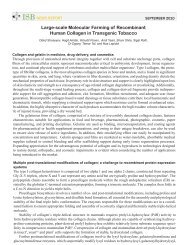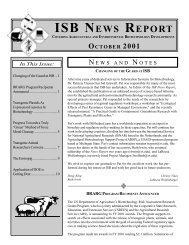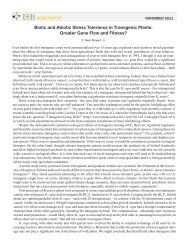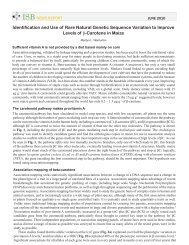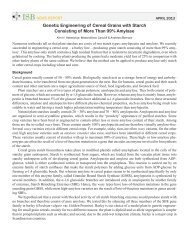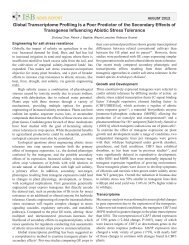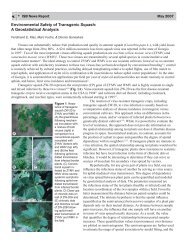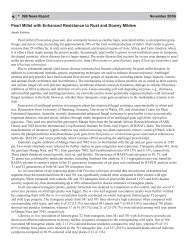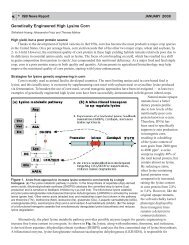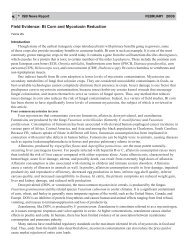isb news report - Information Systems for Biotechnology - Virginia Tech
isb news report - Information Systems for Biotechnology - Virginia Tech
isb news report - Information Systems for Biotechnology - Virginia Tech
You also want an ePaper? Increase the reach of your titles
YUMPU automatically turns print PDFs into web optimized ePapers that Google loves.
ISB NEWS REPORT<br />
COVERING AGRICULTURAL AND ENVIRONMENTAL BIOTECHNOLOGY DEVELOPMENTS<br />
A UGUST 2004<br />
In This Issue:<br />
How Fit Are Genetically<br />
Engineered Mosquitoes? ..........1<br />
Enhanced Drought Tolerance in<br />
Transgenic Rice .......................4<br />
Biotechnological Improvements<br />
of Tea ......................................5<br />
Regulating Plant Genes and<br />
Agbiotech Products –<br />
International Style ....................8<br />
India Produces Indigenous<br />
‘GM Cotton’ .........................10<br />
FAO Document - Molecular<br />
Marker Assisted Selection .....10<br />
I NSECT RESEARCH<br />
HOW FIT ARE GENETICALLY ENGINEERED MOSQUITOES?<br />
Mark S. Hoddle<br />
Genetic engineering, the practice of using molecular tools to insert novel genetic<br />
material of particular interest into an organism’s genome, is a research enterprise<br />
spanning many laboratories globally. This precise <strong>for</strong>m of genetic insertion and<br />
manipulation has great potential <strong>for</strong> custom designing molecular-based solutions<br />
to many pest and disease problems that currently appear intractable when<br />
confronted with conventional management techniques, such as pesticides, or<br />
cultural and biological control practices that aim to eradicate or reduce pest<br />
populations to non-damaging levels.<br />
One area of interest <strong>for</strong> molecular biologists is development of transgenic mosquitoes<br />
refractory to transmission of human diseases such as malaria, dengue<br />
fever, and yellow fever. Trans<strong>for</strong>mation of mosquitoes can be achieved in the<br />
laboratory through transposable elements, units of DNA that move from one<br />
DNA molecule to another where they insert at random. Transposable elements<br />
(e.g., the hermes element from Musca domestica) can be designed to carry<br />
marker (e.g., GFP from jellyfish, which glows green under UV light, facilitating<br />
rapid identification of transgenic individuals) and strategic genes (i.e., genes that<br />
make the trans<strong>for</strong>mant behave in the desired way, such as being unable to<br />
transmit disease-causing organisms) that are expressed following successful<br />
incorporation into the target’s genome.<br />
While significant progress is being made in developing transgenic insect technologies<br />
and effector genes to trans<strong>for</strong>m insect species of interest, very little work<br />
has been done with laboratory-generated genotypes to determine the likelihood of<br />
transgenic insect establishment, population growth, and persistence when competing<br />
with non-trans<strong>for</strong>med wild types in nature. Transgenes conferring fitness<br />
advantages could act to promote the spread of particular genotypes while<br />
transgenes resulting in fitness costs could be a significant impediment to the<br />
establishment and competitiveness of transgenic organisms. There<strong>for</strong>e, creating<br />
insects with appropriate fitness will be critical to the field-level success of<br />
transgenic-based control strategies. While many labs are routinely creating transgenic<br />
mosquitoes expressing various novel characters, rigorous assessment of the<br />
fitness of genetically engineered mosquitoes is lacking. Fitness of transgenic<br />
mosquitoes can be affected by type of transgene inserted, placement of the novel<br />
material within DNA and associated mutations or interruption of functional gene<br />
sequences, and founder effects resulting from inbreeding between small numbers<br />
of trans<strong>for</strong>mants when establishing newly trans<strong>for</strong>med lines.
ISB News Report August 2004<br />
THE ISB NEWS REPORT<br />
The material in this News Report is compiled<br />
by <strong>In<strong>for</strong>mation</strong> <strong>Systems</strong> <strong>for</strong> <strong>Biotechnology</strong>,<br />
funded as the National Biological Impact<br />
Assessment Program by a grant from<br />
USDA/CSREES to <strong>Virginia</strong> <strong>Tech</strong>. Any<br />
opinions, findings, conclusions, or recommendations<br />
expressed in this publication are<br />
those of the author(s) and do not necessarily<br />
reflect the view of the US Department of<br />
Agriculture or of <strong>Virginia</strong> <strong>Tech</strong>. The News<br />
Report may be freely photocopied or<br />
otherwise distributed with attribution.<br />
Current and past issues of the ISB News<br />
Report are available at http://www.<strong>isb</strong>.vt.edu.<br />
Editor: Ruth Irwin<br />
rirwin@vt.edu<br />
To order your free subscription:<br />
Email: Send to <strong>news</strong>@nbiap.biochem.vt.edu<br />
Type subscribe <strong>news</strong><strong>report</strong><br />
[your name] in the message<br />
section. Do not include any<br />
additional text.<br />
Phone: Call 540-231-3747<br />
Web:<br />
Connect to http://www.<strong>isb</strong>.vt.edu.<br />
Select “News Report,” Subscribe.”<br />
ISB welcomes your comments and encourages<br />
article submissions. If you have a<br />
suitable article relevant to our coverage of the<br />
agricultural and environmental applications of<br />
genetic engineering, please email it to the<br />
Editor <strong>for</strong> consideration.<br />
<strong>In<strong>for</strong>mation</strong> <strong>Systems</strong> <strong>for</strong> <strong>Biotechnology</strong><br />
207 Engel Hall<br />
<strong>Virginia</strong> <strong>Tech</strong><br />
Blacksburg, VA 24061<br />
Tel: 540-231-3747<br />
Fax: 540-231-9070<br />
Email: <strong>isb</strong>@vt.edu<br />
Fitness assessment of transgenic insects is an area of research<br />
that needs greater attention immediately if shortcomings associated<br />
with transgenesis are to be identified, and mechanisms underlying<br />
fitness costs are to be understood and ultimately remedied during<br />
the early stages of this emerging technology. University researchers<br />
located largely in the United States, England, and Italy, using<br />
various laboratory-based studies to investigate fitness of transgenic<br />
mosquitoes, are paying closer attention to evaluating fitness of<br />
transgenic mosquitoes. One study examined the fate of transgenes<br />
in Anopheles stephensi, an important vector of Plasmodium that<br />
causes malaria in humans 1 . In studies in which caged transgenic<br />
mosquitoes could interbreed with non-trans<strong>for</strong>med mosquitoes, the<br />
frequency of transgenic alleles declined abruptly and in some<br />
instances died out. The mechanisms underlying poor per<strong>for</strong>mance<br />
were not elucidated but were assumed to be caused by insertion<br />
and position effects of novel genes and inbreeding depression of<br />
transgenic lines following initial creation.<br />
Another research avenue to investigate fitness was to quantify<br />
demographic parameters <strong>for</strong> three lines of transgenic Aedes<br />
aegypti, the vector of yellow fever, and compare them with nontrans<strong>for</strong>med<br />
Ae. aegypti parameters. Several factors affect the<br />
reproductive output of an insect and ultimately its population size<br />
and stability. Important demographic factors are rates of sterility or<br />
egg inviability (i.e., progeny production), sex ratio of offspring,<br />
juvenile viability, development times, and adult longevity. Workers<br />
at the University of Cali<strong>for</strong>nia Riverside demonstrated that transgenic<br />
Ae. aegypti had a significantly diminished capacity <strong>for</strong><br />
population increase in comparison to non-trans<strong>for</strong>med Ae. aegypti,<br />
and that significant differences existed between lines of transgenic<br />
mosquitoes 2 . For example, fecundity was significantly impaired <strong>for</strong><br />
all transgenic lines in comparison to non-trans<strong>for</strong>med mosquitoes,<br />
and one transgenic line produced substantially fewer viable offspring<br />
than its non-transgenic counterparts. In this study, the<br />
authors demonstrated that negative effects of transgenesis on<br />
fitness are not uni<strong>for</strong>m, and a strain that per<strong>for</strong>ms poorly in one<br />
area may outper<strong>for</strong>m other strains when different characters are<br />
measured. For example, impaired fecundity may be correlated with<br />
a significantly shorter pre-oviposition period. Data collected from<br />
this experiment were used to calculate the intrinsic rate of increase—the<br />
rate at which a population can increase when resources<br />
are unlimited and predators are not present. This value<br />
was calculated <strong>for</strong> non-trans<strong>for</strong>med and trans<strong>for</strong>med Ae. Aegypti 2<br />
and inserted into a simple logistic growth equation (Fig. 1). The<br />
model began with a population of five individuals and continued <strong>for</strong><br />
100 generations with a maximum carrying capacity of 100 mosquitoes<br />
in the water container.<br />
In Fig. 1, non-trans<strong>for</strong>med Ae. aegypti significantly outcompeted<br />
all transgenic lines, reaching 50% and 100% of the environmental<br />
carrying capacity 47% and 41% faster than transgenics, respectively.<br />
Based on their intrinsic rate of increase, non-trans<strong>for</strong>med<br />
2
August 2004<br />
ISB News Report<br />
Another strategy <strong>for</strong> controlling pestiferous insects is to<br />
use viruses engineered with specific activity towards<br />
insects, especially caterpillars. Transgenic baculoviruses, a<br />
group of entomopathogenic double-stranded DNA viruses<br />
with genetically enhanced toxicity <strong>for</strong> insects, has been<br />
assessed <strong>for</strong> fitness. These viruses were engineered to<br />
express insect-selective toxins produced by spider and<br />
scorpion genes and kill more rapidly than non-trans<strong>for</strong>med<br />
viruses. Laboratory and field experiments have demonstrated<br />
that genetically engineered baculoviruses that<br />
express insect-selective toxins have reduced reproductive<br />
capacity and rates of transmission. Taken together, these<br />
results suggest that engineered baculoviruses are less fit<br />
than non-trans<strong>for</strong>med parental wild types and will not likely<br />
persist in the environment 4 . It is possible that fitness costs<br />
incurred by genetically engineering insects and viruses will<br />
have similar and fundamental underpinnings that could be<br />
worth elucidating.<br />
Figure 1. Logisitic growth curves <strong>for</strong> non-trans<strong>for</strong>med and trans<strong>for</strong>med<br />
Ae. aegypti using intrinsic rate of increase values from Irvin et al. 2<br />
mosquitoes would be predicted to outcompete transgenic<br />
mosquitoes rapidly. The challenge facing molecular biologists<br />
now is to create a “super-achiever”—a mosquito that<br />
is competitively superior to wild types in nature. This would<br />
require building a transgenic mosquito with superior fitness,<br />
which would result in a shift of its logistic growth curve to<br />
the left of non-trans<strong>for</strong>med mosquitoes (Fig. 1). Development<br />
of a “super-achiever” may be possible with use of<br />
promoters that drive constructs (i.e., transposable element,<br />
marker, and strategic genes) through the target population,<br />
ultimately reducing or replacing non-trans<strong>for</strong>med wild type<br />
populations.<br />
In contrast to the above study, workers in one laboratory<br />
identified no fitness costs associated with mosquito<br />
transgenesis 3 , and in some instances, important traits such<br />
as longevity and fecundity were actually enhanced in<br />
transgenics in comparison to non-trans<strong>for</strong>med conspecifics.<br />
Consequently, it is crucial to develop a comprehensive<br />
understanding of the mechanisms driving these conflicting<br />
outcomes and <strong>for</strong> the development of standardized protocols<br />
<strong>for</strong> laboratories investigating fitness-related issues in<br />
transgenic insects. Adoption of standardized evaluation<br />
techniques would increase our ability to unambiguously<br />
quantify and compare fitness of transgenic insects among<br />
different laboratories.<br />
Transgenesis is an exciting new technology that promises<br />
to revolutionize pest and disease vector control. It is<br />
expected to become an important tool in managing many<br />
pest problems, most likely complimenting the fields of<br />
biological, cultural, and pesticidal control. Like any new<br />
emerging technology, there will be initial problems during<br />
development, and fitness related issues is just one area<br />
among many needing attention. With greater research<br />
ef<strong>for</strong>t, many of the current problems associated with<br />
reduced fitness may be solved once fundamental mechanisms<br />
are better understood, thereby allowing the technology<br />
to advance to field application.<br />
References<br />
1. Catteruccia F, Godfray HCJ, & Crisanti A. (2003) Impact of<br />
genetic manipulation of the fitness of Anopheles stephensi<br />
mosquitoes. Science 299, 1225-1227.<br />
2. Irvin N, Hoddle MS, O’Brochta DA, Carey B, & Atkinson PW.<br />
(2004) Assessing fitness costs <strong>for</strong> transgenic Aedes aegypti<br />
expressing the GFP marker and transposase genes. PNAS 101,<br />
891-896.<br />
3. Moreira L, Wang J, Collins FH, & Jacobs-Lorena M. (2004)<br />
Fitness of anopheline mosquitoes expressing transgenes that<br />
inhibit plasmodium development. Genetics 166, 1337-1341.<br />
4. Cory JS. (2000) Assessing the risks of releasing genetically<br />
modified virus insecticides: Progress to date. Crop Protection<br />
19, 779-785.<br />
Mark S. Hoddle<br />
Biological Control Specialist<br />
University of Cali<strong>for</strong>nia, Riverside<br />
3
ISB News Report August 2004<br />
P LANT RESEARCH<br />
ENHANCED DROUGHT TOLERANCE IN<br />
TRANSGENIC RICE<br />
Teresa Capell<br />
Engineering the plant polyamine biosynthetic pathway<br />
Manipulation of metabolic pathways in plants through<br />
molecular genetics is now possible because of a significant<br />
increase in our knowledge base of how such, often complex,<br />
networks are controlled and regulated. In our ongoing<br />
ef<strong>for</strong>ts to implement rational molecular approaches to<br />
modulate plant metabolism, we chose the polyamine<br />
pathway as a model to unravel key factors that still present<br />
bottlenecks in engineering plant biosynthetic pathways.<br />
The polyamine pathway is ubiquitous in living organisms.<br />
Polyamines are low molecular weight polycationic molecules,<br />
which are thought to play important roles in a<br />
number of physiological and developmental processes 1 . In<br />
animals and fungi, the diamine putrescine (the precursor of<br />
the higher polyamines spermidine and spermine) is synthesized<br />
directly from ornithine by the enzyme ornithine<br />
decarboxylase (ODC). Plants have an alternative route to<br />
the production of putrescine that is catalyzed by arginine<br />
decarboxylase (ADC). Additional reactions convert<br />
putrescine into spermidine and spermine. These steps are<br />
catalyzed by spermidine and spermine synthases, which<br />
add propylamino groups generated from S-adenosylmethionine<br />
by S-adenosylmethionine decarboxylase (SAMDC).<br />
Engineering of the plant polyamine biosynthetic pathway<br />
has concentrated mostly on two species, tobacco and<br />
rice 2,3 . We have generated a diverse rice germplasm with<br />
altered polyamine content. Transgenic rice plants expressing<br />
the Samdc cDNA accumulated spermidine and spermine<br />
in seeds at two to three-fold higher levels compared<br />
to wild type. In a different set of experiments, we were<br />
able to measure a ten-fold putrescine accumulation in<br />
transgenic rice plants harboring oat adc cDNA compared<br />
to wild type. Reduction in endogenous adc transcript levels<br />
in rice resulted in depletion of putrescine and spermidine<br />
pools, with no concomitant changes in expression of<br />
downstream genes in the pathway.<br />
In general, studies focusing on spatial expression of these<br />
transgenes demonstrate that more dramatic changes in<br />
polyamine content occur in storage compared to vegetative<br />
tissues, such as leaves and roots. There<strong>for</strong>e, we believe<br />
that the polyamine biosynthetic pathway in plants is regulated<br />
strongly in a spatial manner 4 . In tomato, enhanced<br />
fruit juice quality and prolonged vine life of fresh fruits with<br />
increased lycopene was achieved by expression of yeast<br />
Samdc driven by the ripening-inducible E8 promoter 5 .<br />
Role of polyamines in stress response<br />
In plants, polyamines accumulate under several abiotic<br />
stress stimuli, including salt and drought. It has been<br />
suggested that this increase in polyamine concentration<br />
could be considered as an indicator of plant stress. The<br />
first demonstration of involvement of polyamines in stress<br />
responses in plants was documented by accumulation of<br />
putrescine in response to sub-optimal K + levels 6 . Since<br />
then, the link between increased putrescine levels and<br />
several abiotic stresses was established. For example,<br />
Krishnamurthy and Bhagwat 7 <strong>report</strong>ed accumulation of<br />
spermidine and spermine in salt tolerant rice cultivars and<br />
accumulation of putrescine in rice sensitive cultivars in<br />
response to salinity stress.<br />
The physiological role of an increase in putrescine accumulation<br />
following abiotic stresses is still unclear and is a<br />
matter of considerable debate. It has been very difficult to<br />
establish directly a cause and effect relationship between<br />
increased polyamine levels in plants and abiotic stress. The<br />
increase in putrescine levels in plants under stress might be<br />
the cause of stress-induced injury or alternatively a means<br />
of protection against stress. Earlier experiments by Roy<br />
and Wu 8,9 expressing oat adc cDNA in rice under control<br />
of an ABA-inducible promoter resulted in transgenic rice<br />
plants with increased biomass when grown under salt<br />
stress. The same authors expressed Tritordeum Samdc<br />
cDNA in rice, under control of the same promoter. Under<br />
salt stress these plants showed increased seedling growth<br />
compared to wild type. Results from a number of studies<br />
suggest that polyamines, particularly spermidine and<br />
spermine, are involved in regulation of gene expression by<br />
enhancing DNA-binding activities to particular transcription<br />
factors. Polyamines are believed to have an osmoprotectant<br />
function in plan cells under water deficit.<br />
A threshold model linking polyamines and abiotic<br />
stress response in plants<br />
Osmoregulatory processes are important to all organisms<br />
<strong>for</strong> stabilization of the intracellular milieu against environmental<br />
fluctuations of water and ions. Despite divergence<br />
of biochemical pathways, both prokaryotic and eukaryotic<br />
organism share several physiological responses to<br />
osmotic stress.<br />
We put <strong>for</strong>ward a threshold model that is consistent with<br />
4
August 2004<br />
high levels of adc gene expression leading to production of<br />
putrescine. The production of putrescine needs to exceed<br />
basal levels in order to generate a large enough metabolic<br />
pool to trigger polyamine flux through the pathway leading<br />
to increases in the levels of spermidine and spermine.<br />
Transgenic rice plants expressing the Datura adc gene<br />
accumulated up to two-fold putrescine in leaf tissues<br />
compared to wild type. Such plants, when subjected to<br />
drought stress induced by 20% polyethylene glycol, exhibit<br />
a very significant divergent behavior compared to wild type<br />
under the same conditions. Following 3 and 6 days of<br />
drought stress, all wild type plants wilt and show droughtinduced<br />
rolling of leaves. Such symptoms are completely<br />
absent from Dadc-transgenic plants, which exhibit significant<br />
putrescine accumulation during the same period. After<br />
the 6-day drought stress period, the phenotype of transgenic<br />
plants is indistinguishable from non-stressed wild<br />
type. Transgenic plants with 2- to 4-fold higher levels of<br />
putrescine develop and set seed normally.<br />
Based on these observations, we put <strong>for</strong>ward a model that<br />
is consistent with a mechanism linking polyamine metabolism<br />
to drought tolerance. Expression of the Dadc<br />
transgene driven by the strong maize Ubi-1 promoter<br />
would augment the putrescine pool to levels that extend<br />
beyond the critical threshold required to initiate the conversion<br />
of excess putrescine to spermidine and spermine 10 .<br />
Spermidine and spermine de novo synthesis in transgenic<br />
plants under drought stress is corroborated by the activation<br />
of the rice samdc gene. Transcript levels <strong>for</strong> rice<br />
samdc reach their maximum levels at 6 d after stress<br />
induction. Such increases in the endogenous spermidine<br />
and spermine pools of transgenic plants not only regulate<br />
the putrescine response, but also exert an anti-senescence<br />
effect at the whole plant level, resulting in phenotypically<br />
normal plants. Wild type plants, however, are not able to<br />
raise their spermidine and spermine levels after 6 d of<br />
drought stress and consequently exhibit the classical<br />
drought-stress response 11 .<br />
Transgenic germplasm we have generated exhibiting<br />
increased tolerance to drought stress is currently being<br />
evaluated in field trials. We are very excited about the<br />
prospects of this germplasm to make a positive contribution<br />
towards sustainable rice production under stress conditions.<br />
References<br />
1. Malmberg RL et al. (1998) Critical Rev Plant Sci 17, 199-224.<br />
2. Kumar A, Minocha SC (1998) Transgenic manipulation of<br />
polyamine metabolism. In: Lindsey K (ed) Transgenic research in<br />
plants. Harwood Academic Publishers UK, pp 187-199.<br />
ISB News Report<br />
3. Capell T, Christou P (2004) Current Opinion in <strong>Biotechnology</strong><br />
15, 148-154.<br />
4. Trung-Nghia P et al. (2003) Planta 218, 125-134.<br />
5. Mehta RA et al. (2002) Nature Biotech 20, 613-618.<br />
6. Richards FJ, Coleman RG (1952) Nature 170, 460.<br />
7. Krishnamurthy R, Bhagwat KA (1989) Plant Physiol. 91, 500-<br />
504.<br />
8. Roy M, Wu R (2001) Plant Science 160, 869-875.<br />
9. Roy M, Wu R (2002) Plant Science 163, 987-992.<br />
10. Bassie L et al. (2000) Trans. Res. 9, 33-42.<br />
11. Capell T, Bassie L, Christou P (2004) Proc. Natl. Acad. Sci. of<br />
USA 101, 9909-9914.<br />
Teresa Capell<br />
Department of Crop Genetics and <strong>Biotechnology</strong><br />
Schmallenberg, Germany<br />
teresa.capell@ime.fraunhofer.de<br />
BIOTECHNOLOGICAL IMPROVEMENTS OF TEA<br />
Tapan Kumar Mondal<br />
Tea (Camellia sinensis L.; family Theacea) is the oldest<br />
non-alcoholic caffeine-containing beverage crop in the<br />
world, and India is currently the <strong>for</strong>emost producer, consumer,<br />
and exporter of commercial tea. The plant is a<br />
woody perennial, traditionally propagated through either<br />
seeds or stem cuttings, with a life span of more than 100<br />
years. Tea is classified morphologically into two varieties:<br />
Assam and China. The young leaves are processed into<br />
different types of tea, such as black, green, and oolong.<br />
Health benefits attributed to tea consumption are well<br />
proven.<br />
Background<br />
Conventional tea breeding is well established, though timeconsuming<br />
and labor intensive due to its perennial nature<br />
and long gestation period (4 – 5 years). Vegetative propagation<br />
is standard, yet limited by slow multiplication rate,<br />
poor survivability of some clones, and need <strong>for</strong> copious<br />
initial planting material. Seed-borne plants are heterogeneous<br />
due to their highly allogamous nature; consequently,<br />
it is difficult to maintain their superior character. Additionally,<br />
tea breeding has been slowed by lack of reliable<br />
selection criteria. Although few morpho-chemical markers<br />
5
ISB News Report August 2004<br />
are available <strong>for</strong> identification of superior cultivars, these<br />
markers are greatly influenced by environmental factors and<br />
show a continuous variation with a high degree of plasticity.<br />
To overcome these problems, a limited number of isozyme<br />
markers have been used, resulting in less polymorphism.<br />
With the advancements of molecular biology, however,<br />
ef<strong>for</strong>ts have shifted to using various DNA markers.<br />
Understanding genetic diversity at the molecular level of<br />
tea germplasm will help to: (1) preserve the intellectual<br />
property rights of the tea breeder; (2) identify individual tea<br />
cultivars through use of a molecular passport; (3) prevent<br />
duplicate entry of different genotypes into the tea gene<br />
pool; (4) increase efficient selection of varieties <strong>for</strong> hybridization,<br />
composite plant production, etc.; (5) classify tea<br />
genotypes taxonomically using molecular markers; and (6)<br />
improve tea varieties <strong>for</strong> agronomically important characteristics<br />
through marker assisted selection. Consequently,<br />
biotechnological tools appear to be the ideal choice to<br />
circumvent problems of conventional tea breeding.<br />
Micropropagation<br />
The development of micropropagation, a rapid in vitro<br />
multiplication method, of tea has passed through three<br />
phases. Until the 1980s, emphasis was on standardizing<br />
parameters of the in vitro protocol, such as using a suitable<br />
explant, overcoming microbial contamination, and optimizing<br />
media composition combined with growth regulation <strong>for</strong><br />
better proliferation. It is now accepted that nodal segments<br />
(0.5-1 cm) cultured on MS medium with BAP (1-6 mg/l)<br />
are best <strong>for</strong> multiplication of shoots, along with either a<br />
high dose (500mg/l) pulse treatment or a low dose (1-2mg/<br />
l) long duration treatment of auxin such as IBA <strong>for</strong> in vitro<br />
rooting. Until the1990s, ef<strong>for</strong>ts turned toward hardening<br />
micro-shoots to achieve a higher survival percentage.<br />
Accordingly, several nonconventional approaches, such as<br />
a CO 2<br />
-enriched hardening chamber, biological hardening,<br />
and micrografting, were developed. Presently, attention is<br />
increasingly focused on evaluating field per<strong>for</strong>mance of the<br />
micropropagated plant.<br />
In our laboratory we developed a micropropagation protocol<br />
by using a novel plant hormone, thidiazuron, which was<br />
commercialized at the Research and Development Department<br />
of Tata Tea Ltd., India. This protocol provides much<br />
faster proliferation rates.<br />
Somatic embryogenesis<br />
One prerequisite <strong>for</strong> genetic trans<strong>for</strong>mation of tea is an<br />
efficient system of regenerating the complete plant from a<br />
single cell. Until today, somatic embryogenesis in tea was<br />
considered the most efficient regeneration system. Unlike<br />
micropropagation, tea somatic embryogenesis started in the<br />
late 1980s. Thus, emphasis was focused on standardizing<br />
parameters, such as genotypes, seed maturity, media<br />
<strong>for</strong>mulation, growth regulator, physical condition, etc. We<br />
developed a complete pathway of tea somatic embryogenesis<br />
in which somatic embryos were first induced within 6<br />
– 8 weeks on the cotyledon segments of mature tea seed,<br />
which were then further multiplied synchronously (Fig. 1).<br />
A germination medium was <strong>for</strong>mulated that yielded a 70%<br />
conversion rate. Following this protocol, we transferred<br />
3,000 plants to the field at the Research and Development<br />
department, Tata Tea Ltd, India 1 .<br />
Figure 1. Occurrence of somatic embryo on the tea cotyledon.<br />
Bioreactor technology <strong>for</strong> secondary embryogenesis<br />
Applications of bioreactor technology further ensure the<br />
speedy, continuous, and large-scale supply of propagule. A<br />
bioreactor system <strong>for</strong> repetitive embryogenesis in tea has<br />
also been developed in Australia 2 in which uni<strong>for</strong>m sizes of<br />
globular somatic embryos were obtained <strong>for</strong> a bioreactor<br />
technology called the temporary immersion system (TIS).<br />
By controlling immersion cycles, synchronized multiplication<br />
(24 fold) and embryo development were achieved with<br />
greater consistency and with a high rate of plant recovery.<br />
Plantlets recovered through this method were hardy, with a<br />
well-<strong>for</strong>med taproot. There<strong>for</strong>e, this technique was the first<br />
significant step <strong>for</strong> commercial application of bioreactor<br />
technology to produce large-scale tea somatic embryos.<br />
Field per<strong>for</strong>mance of micropropagated raised plants<br />
The ultimate success of any in vitro protocol depends upon<br />
per<strong>for</strong>mance of plants in the field compared to vegetative<br />
counterparts. For the last several years, researchers at the<br />
Research and Development Department of Tata Tea Ltd,<br />
India, have transferred more than 45,000 plants of eight tea<br />
cultivars to the field, from which leaves are harvested<br />
regularly to manufacture black tea.<br />
6
August 2004<br />
ISB News Report<br />
Name of <strong>Tech</strong>nique<br />
Objective<br />
Status<br />
Remark<br />
Somaclonal and<br />
Gamatoclonal variation<br />
Develop a mutant resistant<br />
to different stresses<br />
Few plants of drought<br />
tolerance observed in<br />
the laboratory<br />
No commercial success<br />
Artificial seed<br />
Storage of propagule<br />
Nodal segment and somatic<br />
embryos were encapsulated<br />
Maximum 60 days storage<br />
was possible without loss<br />
of germination<br />
Protoplast culture<br />
Haploid and hybrid<br />
plant production<br />
Fusion of two protoplasts<br />
was achieved<br />
Regeneration was not possible.<br />
Anther culture<br />
Production of haploid plant<br />
Development of micro-calli<br />
Regeneration was not achieved.<br />
Suspension culture<br />
Secondary metabolite production<br />
Many secondary<br />
metabolites produced<br />
Commercially exploited<br />
Cryopreservation<br />
Long term storage of propagule<br />
<strong>Tech</strong>nique standardized <strong>for</strong> shoot<br />
tip preservation in liquid nitrogen<br />
Not exploited further <strong>for</strong> either<br />
academic or commercial purposes<br />
Table1: Summary of a sampling of tea cell culture techniques<br />
A systematic study at 1.7, 4, and 8 year-old field-grown<br />
micropropagated and vegetatively propagated tea plants in<br />
our laboratory and elsewhere in India demonstrated that<br />
overall yields and quality were comparable. Although<br />
different physiological parameters such as photosynthetic<br />
rate, chlorophyll content, etc. remained the same, two<br />
morphological variations were noticed. First, the number of<br />
lateral shoots produced after ‘centering’ were significantly<br />
greater in micropropagated-raised plants compared to<br />
vegetatively propagated plants. This is perhaps due to<br />
effects of various growth regulator treatments applied<br />
under in vitro conditions. Second, root volumes of tissue<br />
culture plants were also greater than in vegetativelypropagated<br />
plants. Micropropagated shoots were treated<br />
with IBA to induce rooting, which may be responsible <strong>for</strong><br />
better root development in the field. There<strong>for</strong>e, we concluded<br />
that the micropropagation protocol should be used<br />
only when required to produce a large number of plantings<br />
from a limited source.<br />
Other tissue culture techniques<br />
Other techniques have been applied in tea with specific<br />
objectives (Table 1). Ef<strong>for</strong>ts to improve these techniques<br />
are ongoing at laboratories worldwide.<br />
Genetic trans<strong>for</strong>mation<br />
Transgenic technology has immense potential <strong>for</strong> genetic<br />
improvement of tea; however, until 2000 there were no<br />
<strong>report</strong>s on tea transgenesis. The initial challenge was to<br />
develop a protocol <strong>for</strong> gene transfer. Recently, we <strong>report</strong>ed<br />
the optimization of trans<strong>for</strong>mation conditions and production<br />
of transgenic tea via Agrobacterium tumefaciens 3 . In this<br />
study, we produced transgenic tea using GUS <strong>report</strong>er and<br />
NPT-II marker genes under control of strong monocot<br />
gene promoters, and stepwise antibiotic selection. Using<br />
this protocol, further experiments are underway to transfer<br />
the chitinase gene <strong>for</strong> production of a fungus-resistant<br />
tea plant.<br />
Biolistic-mediated genetic trans<strong>for</strong>mation is another<br />
effective method to produce transgenics in a wide variety<br />
of plant species. Although no transgenic tea plants have<br />
been grown in the field using this technique, experimental<br />
conditions have been standardized by Australian and<br />
Chinese scientists.<br />
Genetic characterization<br />
Morphological markers such as leaf pose, dry matter<br />
production, partitioning, flesh evenness, etc. and biochemical<br />
markers such as total catechin/polyphenol content,<br />
caffeine, etc. are used to identify the superior tea plant.<br />
However, tea breeders are often unable to use markers<br />
effectively because they are greatly influenced by environmental<br />
factors and show a continuous variation with a high<br />
degree of plasticity. Hence, to overcome these problems,<br />
research has shifted to using more sensitive DNA markers.<br />
Work on molecular markers in tea began in our laboratory<br />
in 1994 and a significant amount of work is continuing<br />
worldwide (discussed below).<br />
Research in India:<br />
We have used the random amplified polymorphic DNA<br />
(RAPD) assay to characterize 25 important Indian tea<br />
cultivars and two ornamental species (Fig. 2). In a separate<br />
study, twenty-five diverse tea cultivars were analyzed<br />
7
ISB News Report August 2004<br />
and China tea cultivars were characterized through RAPD<br />
or AFLP, and RAPD, respectively.<br />
Figure 2. DNA fingerprinting pattern of different tea cultivars. Lane 1-<br />
25 denotes different tea cultivar.<br />
using the simple sequence repeat anchored polymerase<br />
chain reaction (SSR-anchored PCR) or Inter SSR-PCR<br />
(ISSR). In both cases, cultivars were analyzed using<br />
Shannon’s diversity index, which revealed that the China<br />
type tea group is more diverse than the Assam group.<br />
Additionally, we noted that molecular classification<br />
matches conventional classification of tea. A speciesspecific<br />
primer was also developed <strong>for</strong> distinguishing<br />
between the Assam and China type tea cultivars.<br />
Amplified fragment length polymorphism (AFLP) markers<br />
were also studied in depth to detect diversity and genetic<br />
differentiation of several important tea clones, including the<br />
famous ‘Darjeeling tea’, mainly to protect cultivars <strong>for</strong><br />
intellectual property rights purposes. Interestingly, the<br />
RFLP technique was also used to detect adulteration with<br />
cashew husk in 10 different tea samples 4 .<br />
Research abroad:<br />
Researchers in different countries have made fingerprints<br />
of tea cultivars in their countries of origin. In Kenya,<br />
fingerprints of popular tea cultivars were made through<br />
RAPD and AFLP analysis at the Tea Research Institute,<br />
Kenya. The same group also initiated a genetic linkage<br />
map of tea. Work is ongoing to develop a complete tea<br />
database with chemical as well as molecular data, which<br />
will assist with easy identification of the different cultivars.<br />
In Japan, a wide range of markers has been used with<br />
various applications. The markers used <strong>for</strong> genetic characterization<br />
of different green tea cultivars are RAPD,<br />
AFLP, SSR, CAPS, and RFLP. Importantly, the RFLP<br />
technique was also applied in Japan to prevent adulteration<br />
of higher grade with lower grade tea. Several other minor<br />
tea-producing countries have used different molecular<br />
markers to characterize the tea gene pool of introduced tea<br />
cultivars available to that country. Such ef<strong>for</strong>ts were made<br />
using RAPD in Portugal, ISSR in Taiwan, and RAPD in<br />
South Africa. All work focused on the genetic characterization<br />
and molecular taxonomy of the introduced variety<br />
available in the respective countries. Similarly, South Korea<br />
Simple sequence repeats (SSR) were derived from C.<br />
japonica, a closely related species of tea in Japan. Using<br />
these primer pairs, 53 C. japonica ecotypes were<br />
genotyped and population genetic parameters calculated.<br />
Later, the same group investigated the spatial genetic<br />
structure of C. japonica using four of these microsatellite<br />
primers. Spatial distribution of individuals was also assessed<br />
to obtain an insight into spatial relationships between<br />
individuals and alleles.<br />
Gene cloning and expression<br />
Japanese researchers have isolated the cDNA chalcone<br />
synthase (CHS) gene as well as ß-tubulin gene from the<br />
Japanese green tea cultivar ‘Yabukuta’. More recently, a<br />
few important genes such as phenyl ammonia lyase<br />
(PAL), caffeine synthetase, and primeverosidase have<br />
been isolated.<br />
References<br />
1. Mondal TK et al. (2004) Plant Cell Tissue Org Cult, Netherlands<br />
76, 195-254.<br />
2. Akula A, Akula C (1999) In: Jain SM, Gupta PK, & Newton RJ<br />
(eds.), Somatic embryogenesis in Woody plants, Vol. 5, pp 239-<br />
259. Kluwer Academic Publishers: The Netherlands.<br />
3. Mondal TK et al. (2001) Plant Cell Reports 20,712-720.<br />
4. Dhiman & Singh (2003) Planta Med 69(9), 882-4.<br />
Tapan Kumar Mondal<br />
Centre <strong>for</strong> Advance Study in Tea Science and <strong>Tech</strong>nology<br />
Uttar Banga Krishi Viswavidalaya, India<br />
mondaltk@rediffmail.com<br />
R EGULATORY NEWS<br />
REGULATING PLANT GENES AND AGBIOTECH<br />
PRODUCTS – INTERNATIONAL STYLE<br />
Phillip B.C. Jones<br />
Challenges from pathogens, pests, and the climate fuel<br />
perpetual ef<strong>for</strong>ts to develop new crops with mixed traits.<br />
When a fungus decimated maize grown in the southern<br />
United States, <strong>for</strong> example, plant breeders devised a way<br />
to defeat the pathogen with a natural resistance trait<br />
harbored within a variety of African maize. To combat<br />
8
August 2004<br />
yellow dwarf disease in U.S. barley varieties, researchers<br />
harvested resistance genes from Ethiopian plants, while<br />
genes from plants originating in the Caucasus and Spain<br />
provided the keys <strong>for</strong> resisting rust disease in U.S. commercial<br />
wheat varieties.<br />
Plant breeders can per<strong>for</strong>m these feats of agricultural<br />
innovation because they can select traits from a wealth of<br />
genetic resources. And since no single country has the full<br />
range of naturally occurring genetic resources, the collection<br />
and exchange of germplasm requires international<br />
cooperation. Yet not every nation considers this exchange<br />
equitable. Accusations of biopiracy often arise from<br />
countries in tropical and subtropical regions, which possess<br />
the majority of the world’s agricultural genetic diversity. At<br />
the same time, changing land use practices within these<br />
countries lead to the loss of uncollected genetic resources.<br />
The Food and Agriculture Organization (FAO) of the<br />
United Nations estimates that about three quarters of the<br />
genetic diversity found in agricultural crops has vanished<br />
over the last century.<br />
These concerns inspired the creation of the UN’s International<br />
Treaty on Plant Genetic Resources <strong>for</strong> Food and<br />
Agriculture, an agreement adopted after seven years of<br />
negotiations by delegates from 116 nations. Although<br />
drafted in November 2001, the Treaty only came into <strong>for</strong>ce<br />
on June 29, ninety days after <strong>for</strong>ty governments ratified it.<br />
José Esquinas-Alcázar, secretary of FAO’s Commission on<br />
Genetic Resources <strong>for</strong> Food and Agriculture, told BBC<br />
News Online that the “treaty will ensure the conservation<br />
and availability of raw material <strong>for</strong> agriculture.”<br />
The agreement requires each contracting party to explore<br />
and conserve its plant genetic resources <strong>for</strong> food and agriculture.<br />
Parties can work toward this objective by surveying<br />
their genetic resources and assessing any threats, and<br />
by promoting both in situ conservation and the compilation<br />
of genetic resources <strong>for</strong> preservation in public collections.<br />
The treaty also mandates that contracting parties develop<br />
and maintain measures to advance the sustainable use of<br />
plant genetic resources. Examples of such measures<br />
include extending the genetic base of crops available to<br />
farmers and supporting plant breeding ef<strong>for</strong>ts that<br />
strengthen the capacity to develop varieties adapted to<br />
particular ecological conditions.<br />
Under the Treaty, countries agree to establish a Multilateral<br />
System to facilitate access to plant genetic material and to<br />
share the benefits. The Multilateral System applies to plant<br />
genetic resources <strong>for</strong> food and agriculture listed in the first<br />
ISB News Report<br />
annex of the Treaty that are under the control of the<br />
contracting parties and in the public domain. The 35<br />
itemized food crops and 29 <strong>for</strong>age crops “represent most of<br />
the important food crops on which countries rely,” says<br />
Esquinas-Alcázar. According to one estimate, the Treaty’s<br />
annex lists crops representing 80 percent of the world’s<br />
calorie intake. The 600,000 sample gene bank collection<br />
held by the Consultative Group on International Agricultural<br />
Research will also be administered under the Treaty.<br />
Restrictions apply to the use of these genetic resources.<br />
The material must be used to promote conservation,<br />
research, breeding, and training <strong>for</strong> food and agriculture.<br />
Any use of genetic material <strong>for</strong> chemical, pharmaceutical,<br />
and other industrial applications falls outside the scope of<br />
the Treaty. If an entity incorporates material accessed from<br />
the Multilateral System into a commercial food or agricultural<br />
product and does not permit others to use the product<br />
without restriction <strong>for</strong> research and breeding, then the<br />
Treaty requires payment of an equitable share of any<br />
resulting monetary benefits.<br />
The FAO asserts that the Treaty benefits agricultural<br />
research because the Multilateral System will reduce<br />
transaction costs <strong>for</strong> the exchange of plant genetic material<br />
between countries. That is, researchers will no longer have<br />
to negotiate bilateral agreements with each donor country<br />
to obtain germplasm.<br />
But be<strong>for</strong>e the Treaty can facilitate any transfer of plant<br />
genetic material from its germplasm clearinghouse, the<br />
countries that ratified the agreement must decide about<br />
conditions <strong>for</strong> access and benefit-sharing, details that will<br />
be embodied in a standard material transfer agreement.<br />
Conditions recited in this key document will also determine<br />
whether the United States will ratify the Treaty.<br />
At least one mystery resides within the Treaty. Article 12<br />
states that “recipients shall not claim any intellectual<br />
property or other rights that limit the facilitated access to<br />
the plant genetic resources <strong>for</strong> food and agriculture, or their<br />
genetic parts or components, in the <strong>for</strong>m received from the<br />
Multilateral System.” Even delegates involved in the<br />
drafting of the document could not agree about the meaning<br />
of this statement.<br />
It might have been the eruption of biopiracy complaints that<br />
motivated the inclusion of the ambiguous passage. During<br />
the drafting of the Treaty, protests from India provoked the<br />
revocation of a U.S. patent covering a use of turmeric and<br />
a European patent on a compound derived from the Neem<br />
tree, while South American activists prompted the with-<br />
9
ISB News Report August 2004<br />
drawal of a U.S. patent on an ayahuasca vine variety. In<br />
2001 alone, India, Pakistan, and Thailand voiced grievances<br />
about a U.S. patent on a type of basmati rice, and Mexico<br />
protested a U.S. patent on yellow beans.<br />
A copy of the Treaty is available from the FAO website<br />
(http://www.fao.org/ag/cgrfa/itpgr.htm).<br />
Labeling Food as Genetically Modified and Living<br />
Modified Organisms as Pests<br />
In June the Codex Alimentarius Commission released its<br />
<strong>report</strong> of the 32nd Session of the Codex Committee on<br />
Food Labeling. The delegates generally supported the<br />
establishment of guidelines <strong>for</strong> end-use labeling—the<br />
labeling of foods derived from genetic engineering that<br />
have a significant change in composition, nutrient content,<br />
or intended use.<br />
Production labeling was met with less enthusiasm. Certain<br />
delegates, including the U.S. delegation, asserted that<br />
consumers would perceive labeling based solely on the<br />
method of production as a safety warning. The Canadian<br />
delegation argued that method of production labeling fails<br />
to comply with Codex’s own rule: only factors accepted<br />
worldwide should be taken into account as a basis <strong>for</strong><br />
decision-making. A copy of the <strong>report</strong> can be obtained<br />
from the website of the Codex Alimentarius Commission<br />
(http://www.codexalimentarius.net/).<br />
On June 1, the FAO published new guidelines <strong>for</strong> determining<br />
if a living modified organism (LMO) poses a hazard to<br />
plants. About 130 countries have adopted this assessment<br />
standard, which focuses on the risk that a <strong>for</strong>eign gene<br />
may trans<strong>for</strong>m a plant into a weed. The document also<br />
offers advice <strong>for</strong> determining whether genetically modified<br />
insects, fungi, or bacteria could harm plant ecosystems. If<br />
authorities deem an LMO a threat, then they can decide<br />
whether to prohibit or restrict its import and domestic use.<br />
The website of the International Plant Protection Convention<br />
offers a copy of the guidelines, entitled “Pest Risk<br />
Analysis <strong>for</strong> Quarantine Pests, Including Analysis of<br />
Environmental Risks and Living Modified Organisms”<br />
(http://www.ippc.int/).<br />
Selected References<br />
Anonymous. (2004) Plant gene treaty becomes law. BBC News.<br />
June 29, 2004. Available at: http://<strong>news</strong>.bbc.co.uk/2/hi/science/<br />
nature/3849489.stm.<br />
Fowler C. (2003) The status of public and proprietary germplasm<br />
and in<strong>for</strong>mation: An assessment of recent developments at FAO.<br />
IP Strategy Today, No. 7-2003. Available at: http://<br />
www.biodevelopments.org/.<br />
Sullivan SN. (2004) Plant genetic resources and the law. Past,<br />
present, and future. Plant Physiology, 135: 10-15.<br />
Phillip B.C. Jones, PhD., J.D.<br />
Spokane, Washington<br />
PhillJones@nasw.org<br />
INDIA PRODUCES INDIGENOUS ‘GM COTTON’<br />
P Janaki Krishna<br />
Insects, disease, and drought present the greatest impediments<br />
to realizing expected yields in major crops. In<br />
addressing these problems, development of transgenic<br />
varieties has assumed significance, primarily through use of<br />
durable resistance genes. However, a few multinational<br />
companies in developed countries own and patent many of<br />
these genes. In developing countries, these novel genes are<br />
sometimes available to scientists as ‘gifts’ through personal<br />
contacts. Though initial transgenic crop development is<br />
dependent on these borrowed genes, the varieties developed<br />
from them would not be available <strong>for</strong> commercial<br />
cultivation because of contractual obligations generally<br />
underlying the ‘gift’ to investigators (as these genes<br />
generally are available <strong>for</strong> academic and experimental<br />
purposes only). At best, GM plants thus developed could be<br />
tested only <strong>for</strong> their efficacy in solving designated problems<br />
and not developed <strong>for</strong> commercial cultivation. Deployment<br />
of borrowed genes in transgenic crops might also attract<br />
patent problems under new IPR regimes.<br />
Scientists, institutes, and seed companies have there<strong>for</strong>e<br />
decided to convene and begin searching and licensing<br />
indigenous genes and technologies <strong>for</strong> endogenous developments.<br />
Apparently this exercise is having an effect, as<br />
Monsanto’s monopoly on genetically modified cotton in<br />
India will soon be broken by Swarna Bharat Biotechnics<br />
Private Ltd (SBBPL), Hyderabad, India, a consortium of<br />
seven Indian seed companies. SBBPL received licenses<br />
<strong>for</strong> two genes derived from Bacillus thuringiensis (Bt),<br />
which protect cotton against bollworm (Helicoverpa<br />
armigera) and tobacco caterpillar (Spodoptera litura).<br />
The genes are licensed from the National Botanical<br />
Research Institute (NBRI), Lucknow, India, <strong>for</strong> Rs. 7.5 ($<br />
0.16) million over a three year period and a royalty of 3%.<br />
SBBPL is soon likely to get license <strong>for</strong> a third gene<br />
(LecGNA 2) that directs production of lectin, a protein<br />
lethal to sucking pests such as aphids, from the publicly<br />
funded Centre <strong>for</strong> Plant Molecular Biology (CPMB),<br />
Osmania University, Hyderabad, India.<br />
10
August 2004<br />
According to NBRI’s Deputy Director, Dr Rakesh Tuli,<br />
SBBPL has licensed two genes—Cry1Ac and another<br />
killer gene called Cry1Ec. Of these two genes, Cry1Ec,<br />
used against a tobacco caterpillar, is designed and synthesized<br />
at NBRI. Because Cry1Ac, which confers resistance<br />
against bollworm, is not protected in India, NBRI’s team<br />
altered Cry1Ac promoters to create a version with greater<br />
expression and stability. According to some experts,<br />
although NBRI has modified the gene, there could be legal<br />
implications: GM plants derived from this gene might come<br />
under the category of ‘essentially derived varieties’<br />
(EDVs) and cannot be registered under India’s Plant<br />
Variety Protection Act - 2001. Even more, Monsanto might<br />
contest the commercialization of Indian indigenous Bt<br />
cotton after January 2005, the date when India has to<br />
comply with patents covered under the WTO rules. Tuli<br />
admits that only time might solve the problem. Meanwhile,<br />
SBBPL is seeking regulatory approval in India <strong>for</strong> both<br />
Cry1Ac and Cry1Ec, with a view toward introducing the<br />
new Bt cotton by 2006.<br />
The consortium’s aim is to enter an era of self-sustaining<br />
agribiotech development. Satish Kumar, Managing Director<br />
of SBBPL, reiterated that they are ready to source beneficial<br />
genes from any publicly funded laboratory where they<br />
are available. The consortium opines that the advantages of<br />
sourcing indigenous technology are economic and strategic.<br />
The profit generated by public sector institutes through<br />
licensing helps support reinvestment in developing more<br />
agribiotech products to serve local needs. The main benefit<br />
<strong>for</strong> consortium members is economic, as the technology<br />
access fee is shared by members of the consortium. In<br />
addition, Indian partners help with the regulatory process to<br />
obtain product approval. Kumar expects that the price of<br />
SBBPL seeds would be two-thirds of Monsanto’s.<br />
Through licensing these genes, Rs 10 ($ 0.2) billion spent<br />
on chemical pesticides can be saved by SBBPL, as 90% of<br />
cotton damage is from bollworm and sap sucking pests.<br />
Indian farmers spend about Rs 16 ($ 0.35) billion on<br />
chemical pesticides. With the introduction of novel Bt<br />
cotton varieties, SBBPL, which has a 30% share of the<br />
total Indian cottonseed market, expects to claim some of<br />
the Rs 30 ($0.66) billion market per year that is presently<br />
monopolized by the joint-venture company Monsanto-<br />
Mahyco Biotech, Mumbai, India.<br />
ISB News Report<br />
Since scientific knowledge is indigenous in India, and<br />
smaller players can access costly technology monopolized<br />
by big multinational companies, many eminent scientists,<br />
activists, scholars, and institutes welcomed this initiative of<br />
SBBPL. The activist groups critical of Monsanto’s monopoly<br />
are happy, as 42% of India’s transgenic research<br />
has been based on Monsanto’s gene. “Finally, we seem to<br />
be getting our act together,” said Suman Sahai, Convener<br />
of Gene Campaign, New Delhi, India.<br />
However, Monsanto is not daunted by the competition—<br />
they have already co-licensed the Cry 1Ac gene to nine<br />
more Indian companies whose products are at different<br />
stages. Ranjana Smetacek, the company’s spokesperson in<br />
India, says Monsanto welcomes the widespread usage of<br />
Bt cotton. Meanwhile the Council <strong>for</strong> Scientific and<br />
Industrial Research (CSIR), New Delhi, India, the parent<br />
institute of NBRI, is finalizing the list of countries soon to<br />
file patents <strong>for</strong> novel genes. Experts suggest that the<br />
consortium may try to exploit those GM technologies on<br />
crops <strong>for</strong> which patents held by multinational companies<br />
are now expiring. Prabhakar Rao, Managing Director of<br />
Nujiveedu seeds (Hyderabad, India), the largest company<br />
in the consortium, said that membership would soon reach<br />
19, as many other countries are willing to partner with<br />
them. Hence, it appears that a few multinational seed<br />
companies can no longer monopolize agribiotechnologies,<br />
and local stakeholders can play a crucial role in technology<br />
development and commercialization.<br />
References<br />
1. Nat. Biotechnol. 22, 255-256, 2004.<br />
2. Nat. Biotechnol. 21, 590-591, 2003.<br />
3. Nat. Biotechnol. 19, 895-896, 2001,<br />
P Janaki Krishna<br />
<strong>Biotechnology</strong> Unit, Institute of Public Enterprise<br />
Hyderabad, India<br />
jankrisp@yahoo.com<br />
C ONFERENCE NEWS<br />
Molecular Marker Assisted Selection Document<br />
FAO has published a biotechnology-related summary of<br />
an e-mail conference on “Molecular marker assisted<br />
selection as a potential tool <strong>for</strong> genetic improvement<br />
of crops, <strong>for</strong>est trees, livestock and fish in developing<br />
countries,” which ran from 17 November to 14 December<br />
2003. The document summarizes the main arguments<br />
and concerns raised during the moderated e-mail conference.<br />
The full summary is available at http://www.fao.org/<br />
biotech/logs/C10/summary.htm.<br />
11


